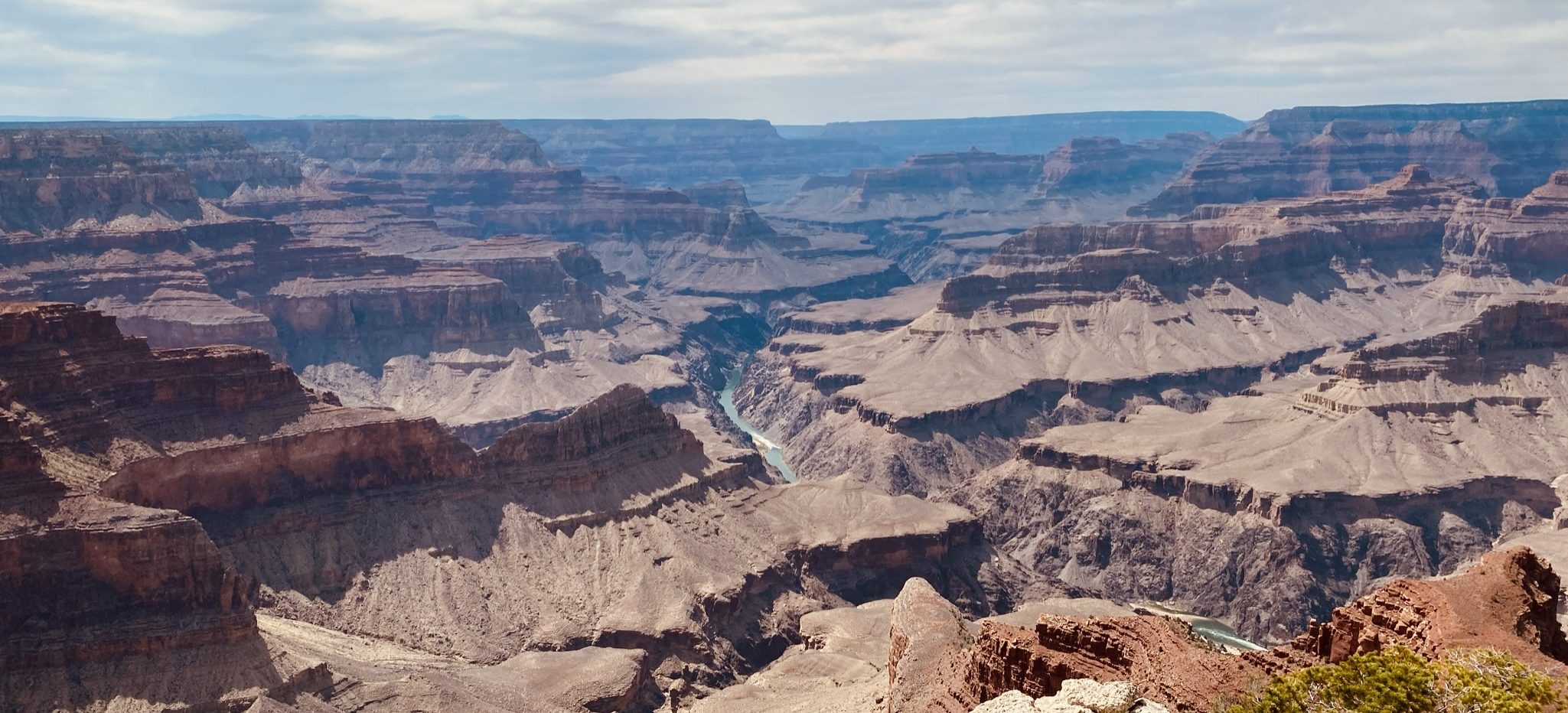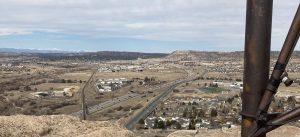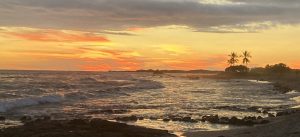Hey dreamers, doers, and those just here for the photos – welcome back.
Have you ever dreamed of doing a road trip? Like in the movies or what you see on TikTok? Beautiful people driving through mesmerizing spots, grand views, and amazing landscapes all bathed in warm sepia-toned filters? Sharing van life stories from macrame-decorated, beige and natural-wood-filled campers? Well, I sure did! I eat up that content, though I am far from polished enough to travel like that. My road trips usually involve way too many people crammed in the car. Homemade sandwiches warming on the dashboard in aluminum foil, and days filled with endless hours of driving.
When I first arrived in the States, I knew I had to take on such an adventure, and I didn’t have to wait long. By the end of May 2021, I’d made some friends, and one of them invited me on a road trip from Denver to the Grand Canyon and back in three days. Squeezed into her host family’s second car with two other Au Pairs, we hit the road in the middle of the night on May 29th.
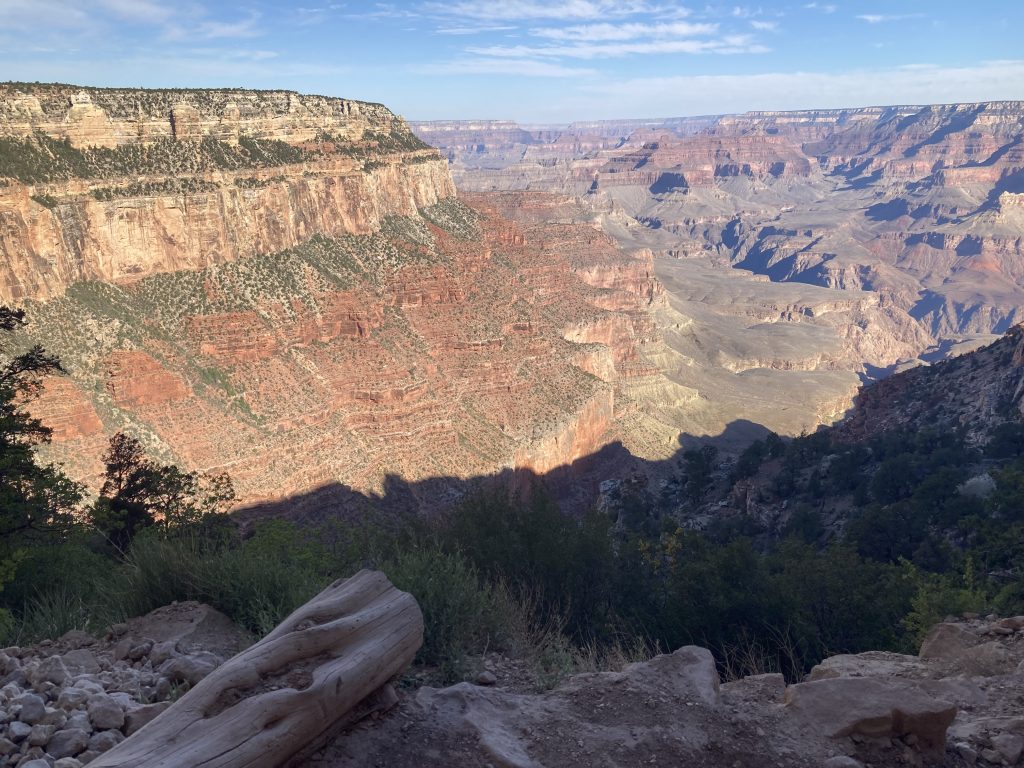
We saw the sunrise from the highway, fueled ourselves with a Costco-sized bag of trail mix, which I still can’t touch to this day, and drove for 11 hours, swapping drivers as we went. Around 6 a.m., we finally arrived at the Grand Canyon. Initially, we planned to jump out of the car and hike immediately to make the most of the cool morning air.
However, exhaustion took over, and we ended up passing out in the car for about an hour. I must have looked like a sight to the other visitors – hat pulled low, scarf draped over my head.
Once we finally got moving, we headed to the South Kaibab Trail, a popular and scenic route that starts from the South Rim at South Kaibab Trailhead. This trail offers options for all hiking levels. If you’re short on time or new to hiking, aim for the “Ooh Aah Point,” just 0.9mi/1.4km from the trailhead. It’s a manageable walk with breathtaking views – a perfect choice if you don’t want to overdo it.
For the more adventurous, the South Kaibab Trail extends all the way to the Colorado River, crossing paths with other trails along the way.
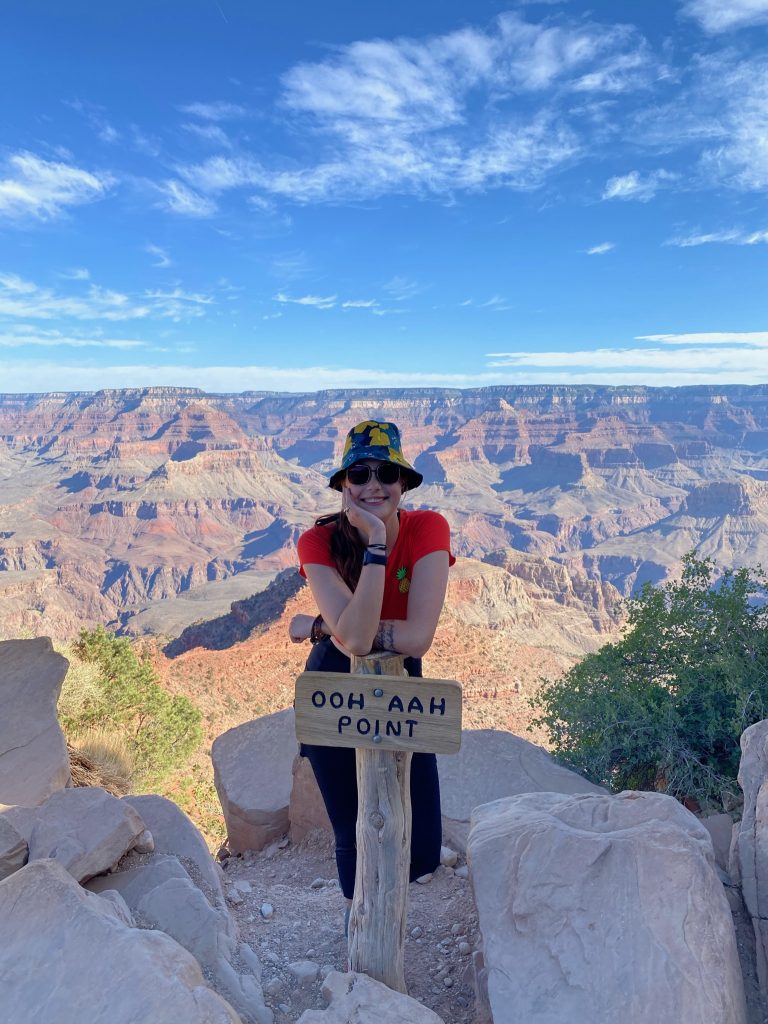
Keep in mind that while going down feels easy, the return hike is a real challenge. Make sure to carry plenty of water and pace yourself! We didn’t go all the way down, so I can’t speak from personal experience about reaching the base of the Grand Canyon. However, I can offer this essential advice:
Hiking down and back up in one day is not recommended.
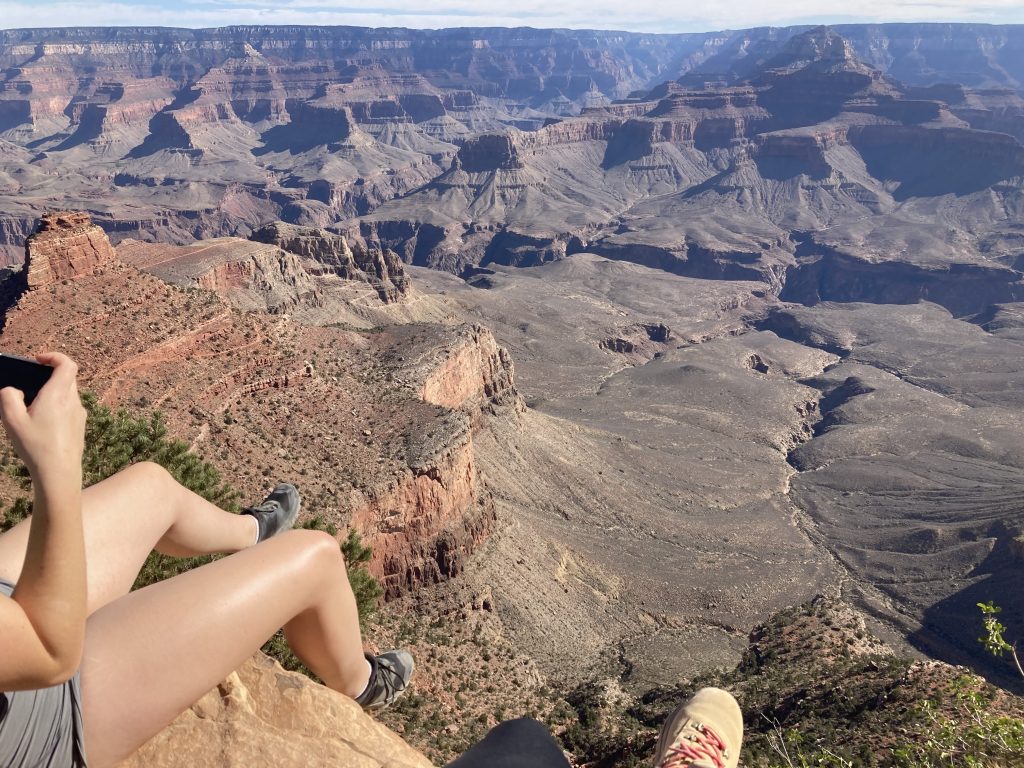
The elevation change is significant – up to 5,000 ft (1,500m) – and the air is thinner at the rim compared to within the canyon. This makes the return hike much more strenuous. If you’re planning to go all the way to the bottom, expect to spend three to four days in the canyon.
Definitely go to the Backcountry Information Center and talk to a Ranger to make sure you are up for the trip. While in the Canyon, you are responsible for your own safety and rescue might take hours or days since you might be in a hard to reach area.
In general make sure that you know where you’re going and prepare accordingly:
Carry a detailed physical map, as phones may lose signal.
Pack enough water for your hike, snacks, and first aid essentials.
Bring sunscreen, a hat, and wear layers of clothing. The canyon gets warmer as you descend, so be prepared for changing temperatures.
Consider carrying a whistle to signal for help in emergencies.
As always, plan your trip thoroughly and consult experienced hikers or park staff for additional guidance.
As stated before: we didn’t hike all the way into the canyon, stopping at Ooh Aah Point before heading back was the ideal trip for us. Even for this relatively short hike – roughly two hours round trip -preparation is essential.
Closed-toe shoes, the terrain is uneven, and flip-flops just won’t cut it.
A hat and sunscreen, the sun can be harsh, even in the early hours.
Water, stay hydrated; dehydration is a common issue for unprepared hikers.
During our hike, we saw several people heading down in flip-flops and without so much as a water bottle. On our way back, we passed many of them, struggling with blisters, exhaustion, dehydration or injury.
Please!
Don’t overestimate your abilities or take unnecessary risks. The Grand Canyon is breathtaking, but it does demand respect. A little preparation goes a long way in ensuring you enjoy the experience rather than enduring it.
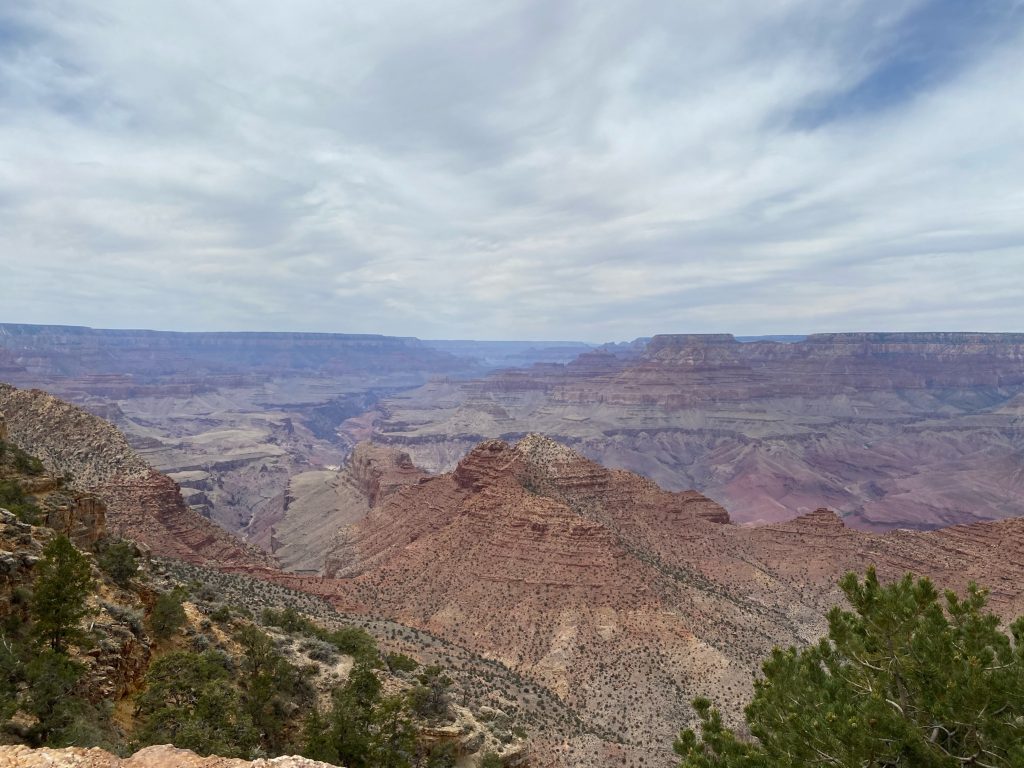
If you’re not into hiking at all and can’t think of anything worse than being in a spot where you can basically touch the canyon’s walls, think about staying on the south rim. The trailheads themselves offer stunning views, and spots like Pipe Creek Vista are perfect for soaking it all in without venturing too far.
Another option is the Desert View Drive, a 23-mile (37 km) scenic route that begins at the South Entrance of the park. Before you start, make a quick stop at the Visitors Center to grab a map and any updates. This drive takes you through some of the most breathtaking viewpoints, including Yaki Point, Grandview, and Moran. As the road winds eastward, it concludes at Navajo and Desert View Points, eventually leading you to the park’s East Entrance.
For those who’d rather let someone else do the driving, the park offers a shuttle system with four routes to help you explore effortlessly. These routes will take you around the park and let you see the best spots you might not be able to reach in your own car. Just make sure to be at the stops on time and to not miss the last bus!
If you want to spend 1-2 hours at the park you won’t have much time to actually hike but you’ll be able to catch the Kaibab/Rim Route which is the orange line. It runs year round and loops east and west starting from the Visitors center. It takes you to the best Trailheads and viewpoints as well as the geology museum on the south rim.
If you plan to hike but want to skip the stress of parking, consider the Hikers Express. Running early in the morning, this bus is designed to get hikers from the village to the South Kaibab Trailhead. It’s a straightforward express service, so be mindful that it won’t bring you back to the village later in the day. It runs from 8-9am in winter and 5-6 am in summer.
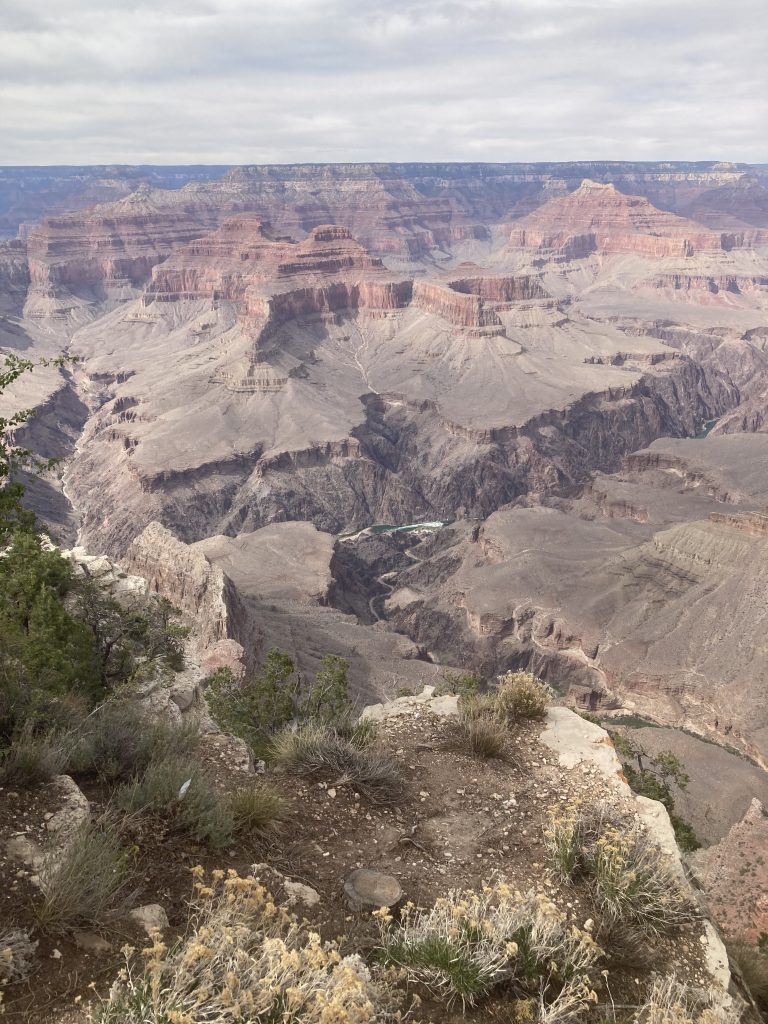
If you have more time to explore, consider checking out the Hermits Rest Route, known as the Red Line. To get there, you’ll first take the Village Route (the Blue Line), which operates year-round. This connects the Visitors Center to key spots like the village, the Backcountry Information Center, Bright Angel Trailhead, and the Hermits Rest Route Transfer Station. However, keep in mind that the Red Line itself only runs from March 1 to November 30.
The ride up to Hermits Rest is worth it – not just for the views, but also for the lively commentary you might get from your driver.
Like this fun fact: falling into the canyon’s deepest point would take only about 12 seconds to reach the bottom.
The Hermits Rest site, originally designed by Mary Colter in 1914, mimics a miner’s cabin and serves as a visitor spot complete with a gift shop, restrooms, and a small snack bar open from 9 am to 5 pm. We grabbed ice cream here, the sandwiches were a bit pricey for our taste. The building itself has never been lived in, but the area it occupies was once home to Louis Boucher, a Canadian-born explorer and miner who built the Hermit Trail in 1891. Boucher eventually worked as a Grand Canyon guide after abandoning his quest for gold. Today, Hermits Rest marks the western end of the South Rim, and it’s also the starting point for the Hermit Trail, which leads down to the Colorado River.
The East end of the South Rim is marked by the Desert View Watchtower, built by Mary Colter as well and sitting at the East Entrance of the park. The large observation deck-like area gives you the best view of the canyon from the east, as well as the Colorado Rivers “Big Bend” and you might even be able to see the Painted Desert in the distance. The Tower itself can be reached by following the South Rim Drive. The Orange line does go in the right direction but cuts off to Yaki point so you’d have to walk a good bit. The Watchtower is open from 9am to 5pm and you can climb it as well, free of cost. Do note that there are not unlimited tickets and you might have to wait a bit before going up.
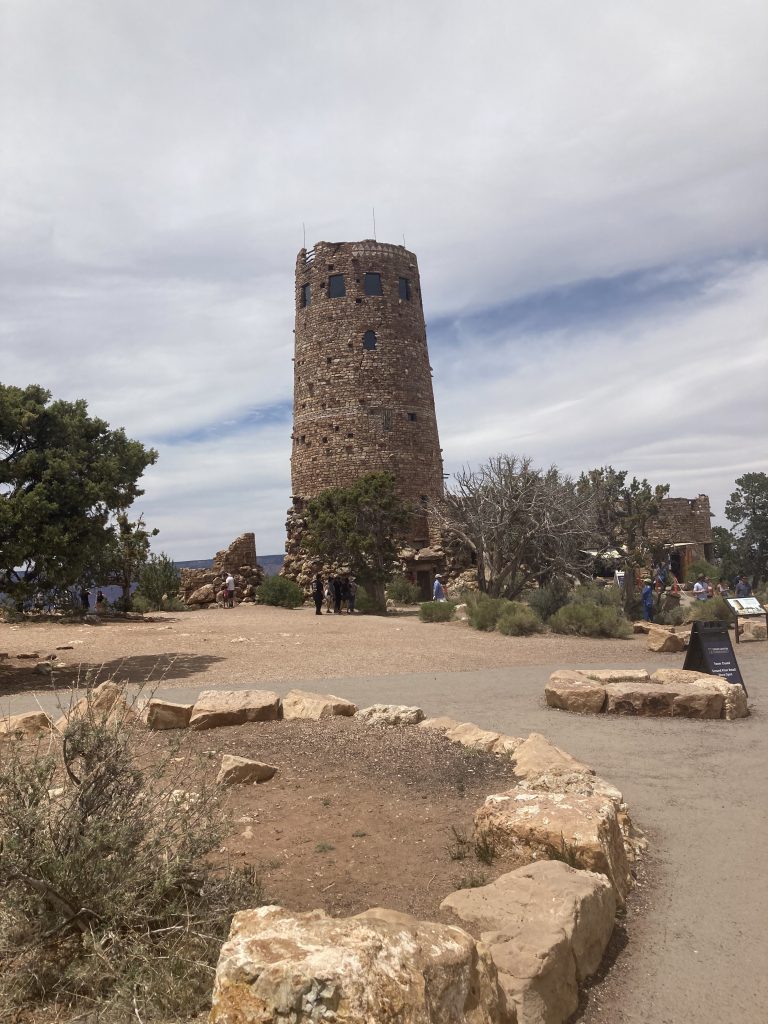
The lower floor of the tower is dedicated to show cultural demonstrations by indigenous artists from spring till the end of fall and houses a gift shop as well.
Maybe you’re able to spot the “reflectoscopes”, polished mirrors that cut through haze and glare and let you see the colors and magic of the canyon in a new light.
At a Glance:
Located in northern Arizona, close to Phoenix and Las Vegas. If you plan on staying a night, you can also check out the lodgings in and around the canyon or you also have the option to go camping! Note that some of the parking lots do not allow overnight parking. From Denver, it’s around a 12-hour drive, and there are plenty of things to see on the way, so maybe add a couple of days and make it a fun road trip!
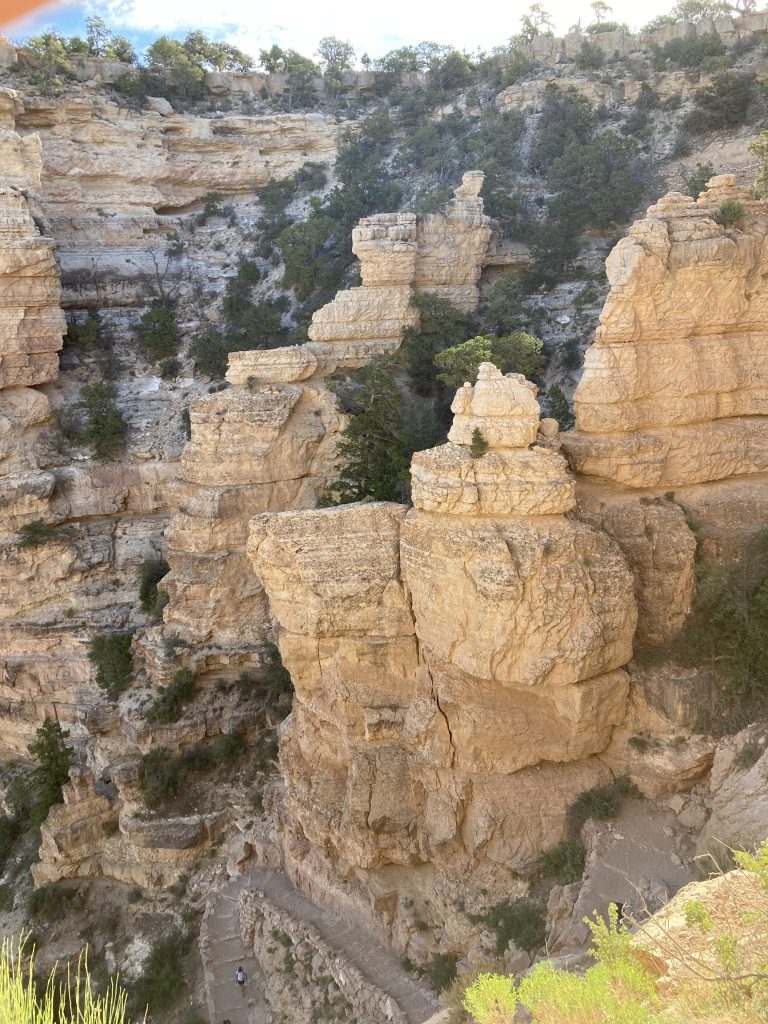
The best time to go is late spring or early fall, so expect crowds around holidays like spring break. The South Rim is open year-round, 24 hours a day. There are a couple of days with free entry. Make sure to check their website for dates, as they might change each year! You never need a reservation unless you want to camp in specific campgrounds, but all that info is available here. The standard entrance fee is $35 for a private vehicle, $30 for motorcycles, or $20 per person. You can purchase the pass online or cashless upon arrival. Definitely check out the “America the Beautiful Pass” if you’re visiting at least two parks in the next 12 months! It’s $80 and allows you to visit all recreation areas across the states!
The canyon is not without reason “grand”; it spans over 277 mi/445.7 km in length, is up to 18 mi/28.9 km wide, and up to a mile/1.5 km deep! There are plenty of hiking trails, from just 0.3 mi/0.48 km to a whopping 12.8 mi/20.6 km, and there is something for everybody. You don’t have to hike all the way down to have amazing views either. If you have some hours on your hands, check out the “Ooh Aah Point,” Hermit’s Rest, and the Watchtower. Some of these are reachable by hiking only, while others are accessible by shuttle buses that depart from the Visitors Center.
Okay now that we have talked a whole lot about the Grand Canyon and all its wonders, I hope you’re excited to dust off your hiking boots, get that backpack ready and fill up your snack stash to get going? This is basically part one of my first road trip so stay tuned for the next stop, Monument Valley, Horseshoe Bend and Hole in the Rock! Let me know what your favorite travel snack is and which one you have had so often that you can’t stand it anymore! (looking at you, Costco Trail Mix with Yoghurt Nubs….)
TL;DR
What is the Grand Canyon?
A very big canyon in northern Arizona, spanning 277 mi/445.7 km in length, up to 18 mi/28.9 km in width, and up to a mile/1.5 km deep. The whole park is much bigger; it covers over a million acres of land. The river at the bottom of the canyon is the Colorado River, which runs from the Rockies down to the Gulf of California. The oldest rocks at the bottom of the canyon are dated at around 2,000 million years, which means that the canyon is roughly 6 million years old. So, to quote their website: “very young.”
Why should I go there?
There is simply no place on Earth that is quite like it. There are other canyons all over the states and also outside of America, but the Grand Canyon is pretty unmatched in its sheer size. You could easily spend weeks exploring the remote locations within; please only do so if you are experienced in backpacking!
Is it dangerous?
Unless you push your limits or stand too close to the edge – no.
When is a good time to visit?
Avoid national holidays as they might be very crowded. Summer and winter can have extreme weather, with temperatures ranging from as low as 2°F (-16°C) to as high as 106°F (41°C). Temperatures and air vary a lot between the rim and the middle of the canyon! So, note that it can be risky to hike too far. Definitely check the website for weather updates and closures
Is there something else to do?
If you don’t want to hike, you can ride the shuttle bus or your car around the rim and stop at the viewpoints to still take in the spectacular views, see sights like Hermits Rest and the Watchtower, or simply spend some money at the gift shops! There’s also a geological museum and the Grand Canyon Village for you to explore
How about hotels?
There are lodgings inside the park which you can check out here. The park is close to Las Vegas and Phoenix as well, so you can check for hotels there, as well as on the way and in smaller surrounding towns. Maybe you’re on your way to the West Coast anyway, and this is just a stop?
Should I go there if I don’t like the outdoors?
Well, as said before, you don’t need to hike. But this is a nature park and a natural wonder.
How long should I stay?
Depending on what you plan on doing, you should plan at least half a day for a short hike. The longer you have, the better, so you don’t stress out. But unless you’re hiking into the canyon, a day should suffice.
How much does it cost?
$35 for a day pass with a private vehicle, $30 for motorcycles, and $20 per person without a car. Check out the ‘America the Beautiful Pass’ if you’re visiting more parks in the next 12 months.
